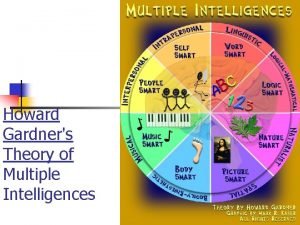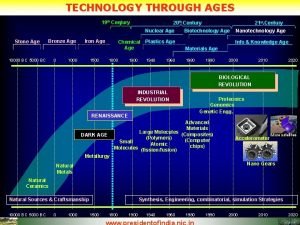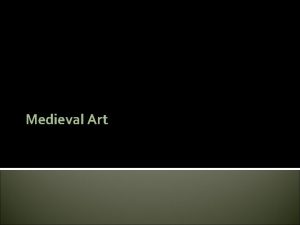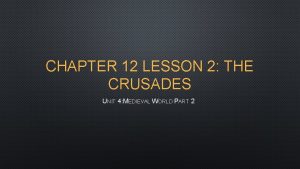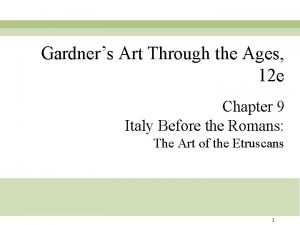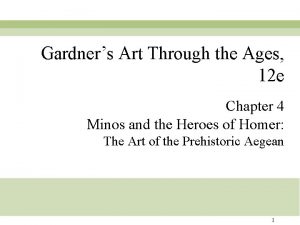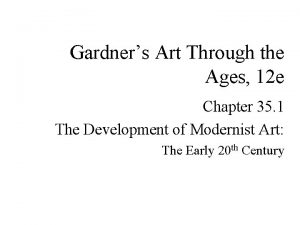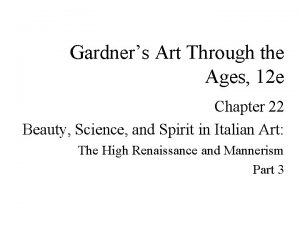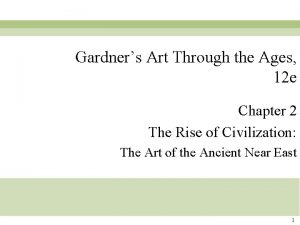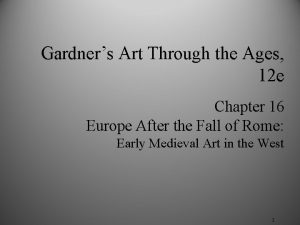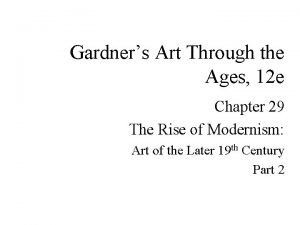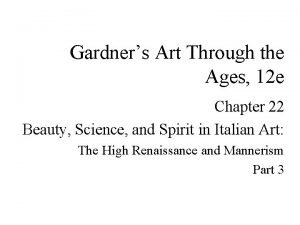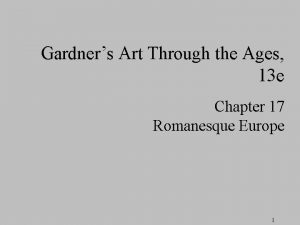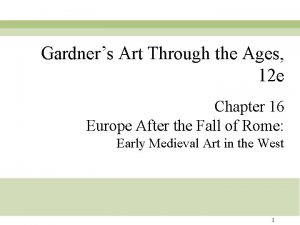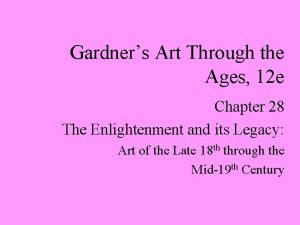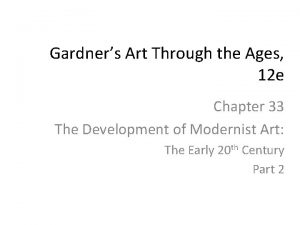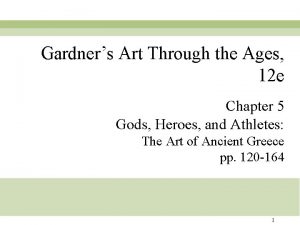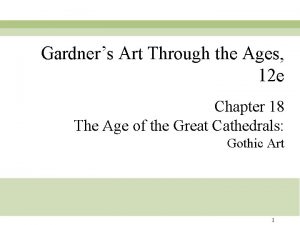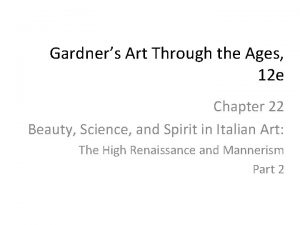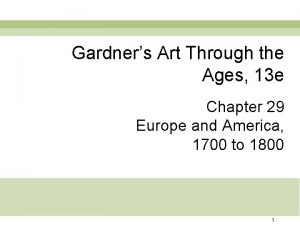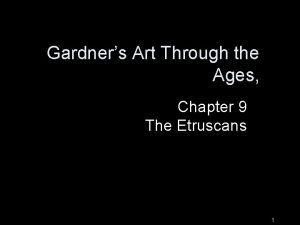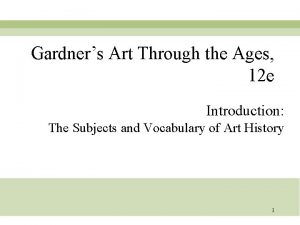Gardners Art Through the Ages 12 e Chapter


















![Roman Architecture in Pompeii • Earliest amphitheater known. [double theater] ca. 7 BCE – Roman Architecture in Pompeii • Earliest amphitheater known. [double theater] ca. 7 BCE –](https://slidetodoc.com/presentation_image/f1804bbd11db0709506f65a675a8aed5/image-19.jpg)

- Slides: 20

Gardner’s Art Through the Ages, 12 e Chapter 10 -1 A From Seven Hills to Three Continents: The Art of Ancient Rome 1

The Roman World 2

Goals • Understand the great innovations of Roman architecture and how these innovations contributed to the expanse of the Roman Empire. • Explore Pompeii for its information about Roman art and architecture. • Examine the types, methods, and subject matter of Roman wall painting. • Understand what Roman portraiture says about Roman society. • Understand the political nature of Roman art and architecture, especially as it communicates ideas of power for the emperor and empire. • Examine changes in Roman art and architecture as a result of expansion of the Roman Empire and the incorporation of the conquered cultures. 3

Historical & Cultural influences on the transition from Classical Greek to Hellenistic Greek Art • Rise of Macedon – after the defeat of Athens in 404 BCE, the Greeks were weakened, and then overcome by Philip II of Macedon, then succeeded by Alexander the Great. • The political upheaval challenged the notion that rational human beings could impose order on their environment. • Refocused on individual rather than the ideal and on the real world of appearances. – The gods were humanized. 4

Historical & Cultural influences on the transition from Classical Greek to Hellenistic Greek Art • The gods were humanized. • Nobility in defeat. 5

Historical & Cultural influences on the transition from Classical Greek to Hellenistic Greek Art • In Hellenistic Greece the center was not Athens, but Antioch, Alexandria and Pergamon. – Much richer, more cosmopolitan culture emerged after Alexander the Great. – The 2 Aphrodites tell the story • By 2 nd cen. BCE the Greeks are under the control of the Romans. 6

Architectural Innovations • Sasanian: Ctesiphon – Barrel Vault • Egyptian: Gizeh – Pyramid 7

Architectural Innovations • Archaic Greece: Mycenae – Corbel Arch • Etruscan: Perugia – Keystone Arch 8

Architectural Innovations: ROME Barrel Vault Groin Vault • Multiple groin vaults allowed for clerestories • The invention of cement made possible an Architecture of Space, not Mass. Hemispheric Dome with Oculus 9

Architectural Innovations: ROME DEFINITIONS: Barrel vault: The extension of a simple arch creating a semi-cylindrical ceiling over parallel walls. It requires buttressing of the walls below the vaults to counteract their downward and outward thrust. Groin or cross vault: Formed by the intersection at right angles of two barrel vaults of equal size. Needs less buttressing and appears lighter than barrel vaults. Pseudo-peripteral: A series of engaged columns that run around the sides and back of the cella to give the appearance of a peripteral colonnade. 10

Temple of Fortunus Virilis ca. 75 BCE Etruscan influences? • The plan—the high podium is accessible only by the front via a wide flight of steps. • Columns are confined to the porch. Greek influences ? • The Ionic features—the fluted columns with bases and the Ionic frieze. • It is built of stone overlaid with stucco in imitation of Greek marble temples. Roman element ? • A series of engaged Ionic half-columns on the sides and back of the cella (pseudo-peripteral). 11

Temple of Vesta, Tivoli early 1 st cen. BCE • Corinthian columns • Podium only reachable by narrow staircase leading to cella door. • Used concrete for cella wall. 12

Sanctuary of Fortuna Primigenia late 2 nd cen. BCE 1 st grandiose complex symbolic of Roman power. • Covered a hillside • Made possible by cement and massive concrete barrel vaults. • Terraces led to central tholos 13

Art of The Republic (509 -27 B. C. ) • The role of Portraits in society. – Temples full of portraits of men from old & Gesii funerary relief ca, 30 BCE distinguished Certified their status as Roman citizens Roman families – Slaves/former slaves had no ancestor portraits as slaves were property. 14

Art of The Republic (509 -27 B. C. ) • Republican Verism: Influenced by Greeks, Etruscans & Egyptians, but celebrated their elevated position in society. • Thought head was enough, vs. the Greeks who wanted the whole body. • Wanted brutal realism, yet would put old head on young body. 15

Caesar Breaks the Rules – 44 BCE • First live person to appear on a coin in Roman [before that distinguished ancestors] 16

The Early Empire (27 B. C. – 98 A. D. ) • Explore Pompeii for its information about Roman art and architecture. • Understand the role of the Colosseum and amphitheater in Roman life. • Understand the concepts, methods and materials of Roman house construction and why it is significant. • Examine the types, methods, and subject matter of Roman wall painting. • Understand the development of Roman art and architecture as the empire expands and develops. 17

Roman Architecture in Pompeii • August 24, 79 CE Pompeii was buried by the eruption of Mt. Vesuvius, thus preserving it for us to see. • Forum: Center of civic life, usually closed to traffic. • 2 story colonnades on 3 sides • “Capitoline”: Temple to Jupiter, Juno & Minerva. • Temple faced into the civic center, not isolated on a hill. • Standard Republican build – tufa covered in stucco. 18
![Roman Architecture in Pompeii Earliest amphitheater known double theater ca 7 BCE Roman Architecture in Pompeii • Earliest amphitheater known. [double theater] ca. 7 BCE –](https://slidetodoc.com/presentation_image/f1804bbd11db0709506f65a675a8aed5/image-19.jpg)
Roman Architecture in Pompeii • Earliest amphitheater known. [double theater] ca. 7 BCE – modeled on Greek. • Radial barrel vaults form a retaining wall & support the earthen mound and the seats. • Painting : Record of a brawl between Pompeians and their neighbors in 59 CE. 19

The Roman House • Inward looking. • Had similar elements. • Were the focus of the social structure of a Roman city House of Vetti – rebuilt 62 -79 CE 20
 Howard gardners theory of multiple intelligences
Howard gardners theory of multiple intelligences Multiple intelligences test
Multiple intelligences test Dark ages def
Dark ages def Dark ages vs middle ages
Dark ages vs middle ages Chapter 7 early childhood ages 3 through 5 answer key
Chapter 7 early childhood ages 3 through 5 answer key Literary archetypes
Literary archetypes Technology through the ages
Technology through the ages What is art of emerging europe
What is art of emerging europe Characteristic of medieval art
Characteristic of medieval art Chapter 12 lesson 2 world history
Chapter 12 lesson 2 world history Eleanor of aquitine
Eleanor of aquitine Sin entered through one man
Sin entered through one man Classes of furcation
Classes of furcation Conversation of timber
Conversation of timber Night of the scorpion nissim ezekiel
Night of the scorpion nissim ezekiel Hát kết hợp bộ gõ cơ thể
Hát kết hợp bộ gõ cơ thể Lp html
Lp html Bổ thể
Bổ thể Tỉ lệ cơ thể trẻ em
Tỉ lệ cơ thể trẻ em Gấu đi như thế nào
Gấu đi như thế nào Thang điểm glasgow
Thang điểm glasgow

